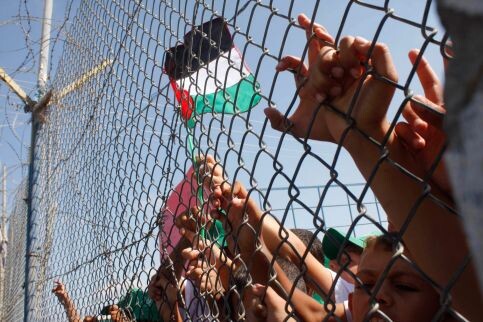The Electronic Intifada 26 July 2010

Under siege and occupation in Gaza, Palestinian children remain under constant risk of Israeli attack. (Hatem Omar/MaanImages)
“She came in through the front door and it wasn’t clear she was injured. Suddenly a lot of blood came from her nose and she vomited, all of the family saw this — her little brothers were very scared. She had just been playing in the front of the house.”
That is how Nihed al-Massry describes what happened to her daughter, nine-year-old Samah Eid al-Massry, after the Israeli army reportedly shelled and fired four bombs into and around a residential area in Beit Hanoun, northern Gaza Strip, on 21 July. Samah is now being hospitalized in serious condition, suffering from extensive blood loss and very low haemoglobin. She was hit by shrapnel and flechettes from a nail bomb that landed 100 meters away, causing internal bleeding to the chest and severe head trauma. Nails are now embedded throughout her body.
Shells containing flechettes are illegal under international law if fired into densely-populated civilian areas. Three other children were wounded in the attack.
Two young men were killed; Muhammad al-Kafarneh, 23, suffered severe shrapnel injuries to the back and chest and Kasim al-Shinbary, 19, was wounded by nails embedded in his skull and shrapnel his back. It was unclear earlier whether they were resistance fighters or if they were civilians.
Haitham Thaer Qasem, a four-year-old boy and an only child, was asleep on a hospital bed, occasionally gasping for breath through the apparatus around his nose. He had suffered deep nasal trauma, and flechette darts from the bomb were still embedded in his tiny body, through his back, right elbow and right leg. He was 200 meters from the impact of the bomb.
Haitham’s mother was standing off to the side, quietly crying while one of his aunts at his bedside explained what happened.
“We had asked Haitham to get shopping for [his mother] from the market, then we heard the bombings and somebody came to our home and told our family that he was in the hospital and was injured in the bombing. We came quickly to the hospital.”
Meanwhile, Samah’s doctor explained that the girl’s blood loss was a major concern. Her injuries are exacerbated by the fact that she, like three of her brothers, already suffers from the blood condition thalassemia and the drug to treat the condition, Exjade, is scarce because of the Israeli blockade. She was clearly in pain and confused, trying to remove the nasal tubes. Her mother showed us the bandages on her chest.
Her doctor, Muhammad Abu Hassan, described her situation as “semi-critical.”
“She was in very bad condition when she arrived — it’s difficult for children and very traumatic to insert a chest tube for small children — very painful. Blood was mainly coming from the chest. We will have to perform surgery and we will further explore her abdominal pain,” he explained.
The al-Massry family has been affected by Israeli attacks before. Samah’s four-year-old brother Ryad was injured during Israel’s three weeks of attacks on the Gaza Strip during winter 2008-09 when more than 400 Palestinian children were killed.
“Our house was hit during the war, a neighbor was killed inside and our son suffered severe head injuries. He wasn’t cared for and because of this his sight is now permanently damaged.”
As we left Samah, she had begun to cry, moaning in serious discomfort and confusion. There were two more injured children in the hospital from the attack, also from the al-Massry family in Beit Hanoun: Azzam Muhammad al-Massry, 11, who suffered a severely fractured left elbow and Ibrahim Wasseem al-Massry, 4, with light injuries to his abdomen.
The previous week in Gaza, Nema Abu Said, a 33-year-old mother of five, was killed by Israeli shelling as she went outside frantically looking for her youngest son after a previous round of shelling. Three more family members were injured by the flechette shells, many of the darts remaining permanently embedded in their bodies.
Adie Mormech is a human rights advocate based in the Gaza Strip who was previously abducted by the Israeli navy from the eighth Free Gaza Movement boat, the Spirit of Humanity. He volunteers with the International Solidarity Movement.

